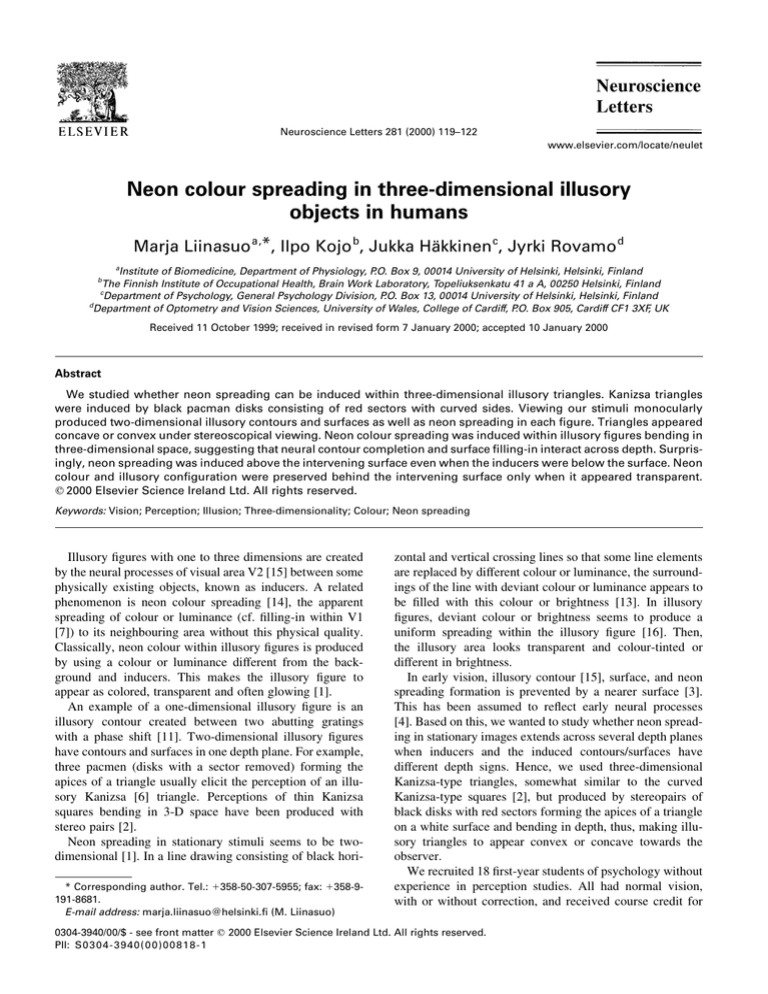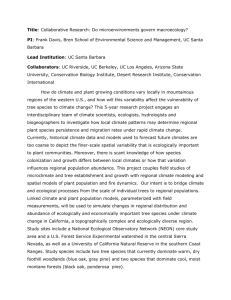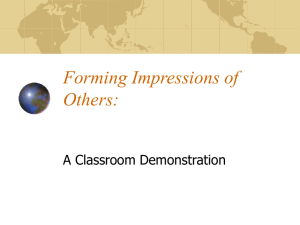
Neuroscience Letters 281 (2000) 119±122
www.elsevier.com/locate/neulet
Neon colour spreading in three-dimensional illusory
objects in humans
Marja Liinasuo a,*, Ilpo Kojo b, Jukka HaÈkkinen c, Jyrki Rovamo d
a
Institute of Biomedicine, Department of Physiology, P.O. Box 9, 00014 University of Helsinki, Helsinki, Finland
The Finnish Institute of Occupational Health, Brain Work Laboratory, Topeliuksenkatu 41 a A, 00250 Helsinki, Finland
c
Department of Psychology, General Psychology Division, P.O. Box 13, 00014 University of Helsinki, Helsinki, Finland
d
Department of Optometry and Vision Sciences, University of Wales, College of Cardiff, P.O. Box 905, Cardiff CF1 3XF, UK
b
Received 11 October 1999; received in revised form 7 January 2000; accepted 10 January 2000
Abstract
We studied whether neon spreading can be induced within three-dimensional illusory triangles. Kanizsa triangles
were induced by black pacman disks consisting of red sectors with curved sides. Viewing our stimuli monocularly
produced two-dimensional illusory contours and surfaces as well as neon spreading in each ®gure. Triangles appeared
concave or convex under stereoscopical viewing. Neon colour spreading was induced within illusory ®gures bending in
three-dimensional space, suggesting that neural contour completion and surface ®lling-in interact across depth. Surprisingly, neon spreading was induced above the intervening surface even when the inducers were below the surface. Neon
colour and illusory con®guration were preserved behind the intervening surface only when it appeared transparent.
q 2000 Elsevier Science Ireland Ltd. All rights reserved.
Keywords: Vision; Perception; Illusion; Three-dimensionality; Colour; Neon spreading
Illusory ®gures with one to three dimensions are created
by the neural processes of visual area V2 [15] between some
physically existing objects, known as inducers. A related
phenomenon is neon colour spreading [14], the apparent
spreading of colour or luminance (cf. ®lling-in within V1
[7]) to its neighbouring area without this physical quality.
Classically, neon colour within illusory ®gures is produced
by using a colour or luminance different from the background and inducers. This makes the illusory ®gure to
appear as colored, transparent and often glowing [1].
An example of a one-dimensional illusory ®gure is an
illusory contour created between two abutting gratings
with a phase shift [11]. Two-dimensional illusory ®gures
have contours and surfaces in one depth plane. For example,
three pacmen (disks with a sector removed) forming the
apices of a triangle usually elicit the perception of an illusory Kanizsa [6] triangle. Perceptions of thin Kanizsa
squares bending in 3-D space have been produced with
stereo pairs [2].
Neon spreading in stationary stimuli seems to be twodimensional [1]. In a line drawing consisting of black hori* Corresponding author. Tel.: 1358-50-307-5955; fax: 1358-9191-8681.
E-mail address: marja.liinasuo@helsinki.® (M. Liinasuo)
zontal and vertical crossing lines so that some line elements
are replaced by different colour or luminance, the surroundings of the line with deviant colour or luminance appears to
be ®lled with this colour or brightness [13]. In illusory
®gures, deviant colour or brightness seems to produce a
uniform spreading within the illusory ®gure [16]. Then,
the illusory area looks transparent and colour-tinted or
different in brightness.
In early vision, illusory contour [15], surface, and neon
spreading formation is prevented by a nearer surface [3].
This has been assumed to re¯ect early neural processes
[4]. Based on this, we wanted to study whether neon spreading in stationary images extends across several depth planes
when inducers and the induced contours/surfaces have
different depth signs. Hence, we used three-dimensional
Kanizsa-type triangles, somewhat similar to the curved
Kanizsa-type squares [2], but produced by stereopairs of
black disks with red sectors forming the apices of a triangle
on a white surface and bending in depth, thus, making illusory triangles to appear convex or concave towards the
observer.
We recruited 18 ®rst-year students of psychology without
experience in perception studies. All had normal vision,
with or without correction, and received course credit for
0304-3940/00/$ - see front matter q 2000 Elsevier Science Ireland Ltd. All rights reserved.
PII: S03 04 - 394 0( 0 0) 00 81 8- 1
120
M. Liinasuo et al. / Neuroscience Letters 281 (2000) 119±122
their participation. It was checked that participating students
were able to perceive (i) stereo ®gures by presenting red and
green stereo pairs, (ii) illusory ®gures by presenting a
Kanizsa triangle with three black pacmen drawn on a
white paper, and (iii) neon colour spreading by presenting
a photo of black pacmen with red sectors usually resulting in
the perception of neon spreading within a Kanizsa triangle.
Five students were eliminated due to failure in perceiving
neon colour spreading. Thus, 13 students (aged 19±35, mean
23 years) served as subjects in the experiments.
The stimulus ®gures were drawn with Illustrator, printed
on ®lm with Digital Palette equipment, and presented as
colour prints using a lenticular stereoscope, Stereopticse
(EARTHings Corp., USA) allowing stereo pair observation
by means of parallel fusion. The device is made of black
cardboard and has holes with lenses allowing eyes to focus
on the plane of the stimulus. Viewing distance was 13.5 cm.
The stimuli were black inducers with white surrounds and
red sectors forming the apices of Kanizsa triangles (Fig. 1).
For all stimuli, the inter-centre distance between the pacmen
was 2 cm (8.58) and their diameter was 1.5 cm (6.48). The tip
of the upper sector and the horizontal edges of the lower
sectors were always on the same depth level relative to each
other. Only the three-dimensional curving and location of
the Kanizsa triangle, relative to the surround, were varied.
In the ®rst and second stimulus, the tip and the horizontal
edges of the lower sectors had null disparity with respect to
the contours of the inducers, and should be perceived to be
in the same plane. The sectors of the ®rst stimulus should
appear convex and above the level of the black inducers
(Fig. 1a, the two on the right/left ®gures for crossed/
uncrossed fusion). In the second stimulus, the sectors should
appear concave and further in depth than the black inducers
(Fig. 1a, the two ®gures on the right/left for uncrossed/
crossed fusion).
In the third stimulus, the tip and horizontal edges of the
lower sectors should appear to be further from the observer
than the inducers. The rest of the convex sectors should
appear closer than the inducers and even penetrate the
white ®eld bearing the inducers (Fig. 1b, the two ®gures
on the right/left for crossed/uncrossed fusion).
The fourth stimulus was the reverse of the third. The tip
and horizontal edges of the sectors should appear closer to
the observer than the inducers. The rest of the concave
Fig. 1. Stimuli used in the experiments. Although only parallel fusion was used, stimuli for converging fusion are also provided. The
instructions are given for parallel fusion; for converging fusion, the opposite applies. Thus, when instructed to fuse the two leftmost
®gures, the convergers should fuse the two rightmost ®gures and vice versa. (a) Fusing the two leftmost ®gures (®rst stimulus) usually
produced the perception of a convex illusory triangle with a reddish surface above the contours of the black inducers. Fusing the two
rightmost ®gures (second stimulus) resulted in the perception of a concave red triangle. Typically, only its apices were visible through
three holes showing a black background, without illusory contours or neon colour spreading. (b) For most observers, fusing the two
leftmost ®gures (third stimulus) produced a perception of a convex illusory triangle with neon colour spreading. The apex of the upper
sector and the horizontal edges of the lower sectors were further away from the observer than the contours of the black inducers; the rest
of the illusory ®gure curved in front of them. The black areas were perceived as holes or funnels. When the two rightmost ®gures were
fused (fourth stimulus), most observers perceived a red concave triangle, only its apices appearing to be closer than the contours of the
black inducers. The rest of the sectors appeared to be further away from the observer than the white surround that appeared to occlude
the central part of a real triangle.
M. Liinasuo et al. / Neuroscience Letters 281 (2000) 119±122
sectors should reach into the distance, penetrating the white
®eld so that they are further from the observer than the
inducers (Fig. 1b, the two ®gures on the right/left for
uncrossed/crossed fusion).
The subjects observed each stereo pair using Stereopticse and reported their impressions aloud. After the
subject gave a spontaneous response, the experimenter
enquired, if necessary: (1) whether the subject saw the illusory triangle: (2) if yes, whether the subject saw contours
around the triangle; (3) about the quality of the illusory
surface, and (4) about its three-dimensional properties,
that is, were some parts nearer or further away from the
observer than others.
Twelve subjects out of 13 perceived neon colour spreading in the ®rst stimulus. Eleven of these perceived a reddish
convex illusory triangle with its apices on the pacmen but
otherwise in front of them and `above' the white surround.
One subject (S.S.) perceived the illusion in the same way but
behind the white surface that was transparent to some
degree. Subject (S.R.), who did not perceive neon colour
spreading, described a glossy uncoloured transparent triangle curving above the white surface.
In the second stimulus eleven subjects did not perceive
neon colour spreading but saw the pacmen as holes through
which the three apices of a red concave triangle were visible; the other parts of the triangle were behind the white
surface. Thus, the whole triangle appeared to be deeper in
depth than the white surface. Two subjects (T.T. and M.K.)
perceived an illusory triangle with neon colour spreading
behind the white surface bearing the contours of the holes.
The white surface appeared suf®ciently transparent to reveal
the red illusory surface, which was not transparent enough
to reveal the black distant surface visible through the holes.
Eleven subjects perceived neon colour spreading in a
convex illusory triangle in the third stimulus. The pacmen
were described as holes or funnels into which the apices
penetrated, while remaining visible. Otherwise the convex
surface was located in front of the white ®eld bearing the
contours of the holes. Two subjects (S.R. and S.S.) reported
a curved triangle, partly occluded by a white plane so that
only apices were visible through the holes in the white
opaque plane, and no neon colour spreading.
In the fourth stimulus twelve subjects reported a concave
triangle, partly occluded by a white surface, with apices
visible since they reached through holes in the white
surface, and no neon colour spreading. Hence, the apices
of the triangle appeared above the white surface whereas the
rest of the triangle was occluded by it. One subject (S.S.)
reported that a concave triangle with neon colour spreading
was visible through the white surface which was partly
transparent.
When the tip of the upper sector and the horizontal edges
of the lower sectors were further away from the observer
than the rest of the con®guration (the ®rst and third stimulus), a convex illusory triangle with neon colour spreading
was perceived by 12 (®rst stimulus) and 11 (third stimulus)
121
subjects out of 13. When the above mentioned parts of the
sectors were closer to the observer than the rest of the
con®guration, a concave, partly-occluded triangle was
usually reported, and the neon effect was reported less
frequently, by only two (second stimulus, x2
1 121,
P , 0:001) and one (fourth stimulus, x2
1 144,
P , 0:001) subjects.
Although illusory contours existed without neon colour in
one case (subject S.R. with the ®rst stimulus), no one saw
neon effects without illusory contours. The other individual
differences in the perceptions seemed to depend on the
perceived location of the white surface with respect to the
red sectors and whether or not the surface appeared transparent to any degree. Subjects S.S. (the ®rst stimulus) and
S.R. and S.S. (the third stimulus) perceived the relative
depth of the illusory or partly occluded triangle differently
from the other subjects. This could be due to a subtle de®cit
in stereo vision.
We found that three-dimensional neon spreading can also
be produced within steady illusory ®gures curving in depth,
extending previous ®ndings [1] where neon effects were
obtained in three-dimensional settings but with ¯at shapes.
Junctions seem to be important in creating neon colour
spreading in ¯at frontoparallel illusory ®gures [17]. Our
experiments show that these junctions do not have to consist
of planar curves but neon effect can also spread from
elements curved in depth.
Illusory contours, surfaces and neon spreading have been
shown to be prevented by a nearer sharp-edged object [3].
This has been assumed to re¯ect early neural processes [4].
However, our experiments with stimulus three showed that
spreading can be induced above the intervening surface
even when the inducers are below the surface, which is
probably re¯ecting later neural processes. The reason for
earlier misinterpretation and limited neural modelling is
the experimental restriction of each set of inducers to a
single depth plane.
Additionally, our experiments showed no neon spreading
when inducers were perceived behind the intervening
surface appearing opaque. These results indicate that neural
computation of transparency/opaqueness modulates the
construct of early processes.
Black inducers generate a glowing white surface, that is,
brightness enhancement in plain illusions. The glowing in
neon ®gures could also be due to this brightness enhancement generated by luminance contrast between inducers and
surround. The use of the same basic neural mechanisms [1]
is also supported by the similar three-dimensional appearance in curved Kanizsa ®gures with (present experiments)
and without [2] colour spreading.
Anatomical, neurophysiological and psychophysical
evidence [5,8,10,12,18] suggests that in early vision illusory
contours, illusory surfaces and neon spreading are processed
in parallel. However, there is evidence that ®lling-in takes
place in V1 [7], illusory contours are processed in V2 [15],
and V4 is the main colour area in primates [19]. Serial
122
M. Liinasuo et al. / Neuroscience Letters 281 (2000) 119±122
processing is also a key element in the neural computation
suggested by Marr [9]. Viewing our stimuli monocularly
shows two-dimensional illusory contours and surfaces as
well as neon spreading in each ®gure. However, stereo
fusion radically alters this precept and even removes neon
colour and illusory con®guration. Our results agree with
serial or parallel processing of 2-D illusory con®gurations
and neon colour spreading but suggest that depth processing
and transparency follow these early neural processes.
[8]
[9]
[10]
Marja Liinasuo was supported by The Academy of
Finland and by The Alfred Kordelin Foundation, Ilpo
Kojo was supported by The Academy of Finland, and
Jukka HaÈkkinen by University of Helsinki, The Finnish
Cultural Foundation, The Alfred Kordelin Foundation, and
Emil Aaltonen Foundation.
[11]
[1] Bressan, P., Mingolla, E., Spillmann, L. and Watanabe, T.,
Neon color spreading: a review. Perception, 26 (1997) 1353±
1366.
[2] Carman, G.J. and Welch, L., 3-Dimensional illusory
contours and surfaces. Nature, 360(6404) (1992) 585±587.
[3] Gregory, R.L. and Harris, J.P., Illusory contours and stereo
depth. Percept. Psychophys., 15 (1974) 411±416.
[4] Grossberg, S., 3-D vision and ®gure-ground separation by
visual cortex. Percept. Psychophys., 55(1) (1994) 48±120.
[5] Hubel, D.H. and Livingstone, M.S., Segregation of form,
color, and stereopsis in primate area 18. J. Neurosci.,
7(11) (1987) 3378±3415.
[6] Kanizsa, G., Quasi-perceptual edges in homogeneously
stimulated ®eds (Walter Gerbino, Trans.). In S. Petry and
G.E. Meyer (Eds.), The Perception of Illusory Contours,
Springer-Verlag, New York, 1987, pp. 40±49.
[7] Komatsu, H., Murakami, I. and Kinoshita, M., Surface repre-
[14]
[12]
[13]
[15]
[16]
[17]
[18]
[19]
sentation in the visual system. Cogn. Brain Res., 5 (1996)
97±104.
Livingstone, M.S. and Hubel, D.H., Psychophysical
evidence for separate channels for the perception of form,
color, movement, and depth. J. Neurosci., 7(11) (1987)
3416±3468.
Marr, D., Vision: a computational investigation into the
human representation and processing of visual information, Freeman, New York, 1982, pp. 397.
Nakayama, K., Shimojo, S. and Ramachandran, V.S., Transparency: relation to depth, subjective contours, luminance,
and neon color spreading. Perception, 19(4) (1990) 497±513.
Soriano, M., Spillmann, L. and Bach, M., The abutting grating illusion. Vis. Res., 36(1) (1996) 109±116.
Van der Zwan, R. and Wenderoth, P., Psychophysical
evidence for area V2 involvement in the reduction of
subjective contour tilt after-effects by binocular rivalry.
Vis. Neurosci., 11(4) (1994) 823±830.
van Tuijl, H.F.J.M., A new visual illusion: neon-like color
spreading and complementary color induction between
subjective contours. Acta Psychol., 39 (1975) 441±445.
Varin, D., Fenomeni di contrasto e diffusione cromatica
nell'organizzazione spaziale del campo percettivo. Riv.
Psicol., 65 (1971) 101±128.
von der Heydt, R., Peterhans, E. and Baumgartner, G., Illusory contours and cortical neuron responses. Science, 224
(1984) 1260±1262.
Ware, C., Coloured illusory triangles due to assimilation.
Perception, 9 (1980) 103±107.
Watanabe, T. and Cavanagh, P., Transparent surfaces
de®ned by implicit X junctions. Vis. Res., 33(16) (1993)
2339±2346.
Watanabe, T. and Sato, T., Effects of luminance contrast on
color spreading and illusory contour in the neon color
spreading effect. Percept. Psychophys., 45(4) (1989) 427±
430.
Zeki, S. and Shipp, S., The functional logic of cortical
connections. Nature, 335(6188) (1988) 311±317.


